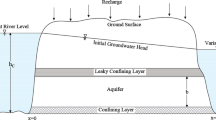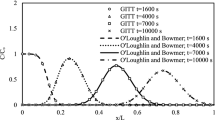Abstract
The present study proposes an analytical solution to a linearized Boussinesq equation considering unsteady downslope river stage, spatio-temporal rainfall recharge, and bedrock seepage. This analytical solution alleviates the limitations of the previous studies like varying river boundary, leaky aquifer bed, and non-uniform recharge simultaneously. The time-dependent river stage depicts the seasonal water level variation in the river, whereas the leakage from the confined to the unconfined aquifer or vice versa represents the bedrock seepage. The analytical expression is derived using the separation of variable method along with a variable transformation technique. The proposed solution is validated using nonlinear numerical and linearized analytical solution. The study highlights that the aquifers with higher bedrock conductivity tend to have a higher inflow rate to the aquifer from the river during monsoon season and a higher outflow rate to the river from the aquifer in the lean period. The analysis also illustrates that for a relatively flat catchment area, with the rise of the water level in the river, there is a reverse flow from the river to the aquifer. Further, the stream stage variation rate is found to be pivotal in deciding the duration of flow direction alteration and volume of water released from the aquifer. Furthermore, a sensitivity analysis is performed to assess the influence of flow parameters on the discharge function. The discharge is found to be positively sensitive to hydraulic conductivity, aquifer slope, and recharge. Finally, the residence time distributions corresponding to various bedrock seepage conditions are examined. Results indicate that the residence time for the various conditions tends to exhibit the heavy-tailed distributions.












Similar content being viewed by others
Data Availability
The code generated and used to plot the water table elevation and discharge function is available from the corresponding author by request.
References
Akylas E, Koussis AD, Yannacopoulos AN (2006) Analytical solution of transient flow in a sloping soil layer with recharge. Hydrol Sci J 51(4):626–641. https://doi.org/10.1623/hysj.51.4.626
Anderson D Jr (1995) Computational fluid dynamics. 6th ed. McGraw-Hill Education
Bansal RK (2012) Groundwater fluctuations in sloping aquifers induced by time-varying replenishment and seepage from a uniformly rising stream. Transp Porous Med 94:817–836
Barenblatt GI, Entov V, Ryzhik V (1990) Theory of fluid flows through natural rocks, Theory and applications of transport in porous media. 3:395. Dordrecht, the Netherlands: Springer
Barlow PM, Moench AF (1998) Analytical solutions and computer programs for hydraulic interaction of stream-aquifer systems. 98–415A, U.S. Dept. of the Interior, U.S. Geological Survey; Information Services [distributor]. https://doi.org/10.3133/ofr98415A
Bartlett MS, Porporato A (2018) A class of exact solution of the Boussinesq equation for a horizontal and sloping aquifer. Water Resour Res 54:767–778
Boggs KG, Van Kirk RW, Johnson GS, Fairley JP, Porter PS (2010) Analytical solutions to the linearized Boussinesq equation for assessing the effects of recharge on aquifer discharge. J Am Water Resour Assoc 46(6):1116–1132
Brutsaert W, Ibrahim HA (1966) On the first and second linearization of the Boussinesq equation. Geophysical J International 11(5):549–554. https://doi.org/10.1111/j.1365-246X.1966.tb03166.x
Brutsaert W (1994) The unit response of groundwater outflow from a hillslope. Water Resour Res 30(10):2759–2763
Brutsaert W (2005) Hydrology: An Introduction. Cambridge Univ. Press, Cambridge, U. K.
Chow VT, David RM, Larry WM (1988) Applied Hydrology. McGraw-Hill
Dralle DN, Boisrame GFS, Thompson SE (2014) Spatially variable water table recharge and the hillslope hydrologic response: analytical solution to the linearized hillslope Boussinesq equation. Water Resour Res 50:8515–8530
Fan Y, Li H, Miguez-Macho G (2013) Global patterns of groundwater table depth. Science 339(6122):940–943. https://doi.org/10.1126/science.1229881
Guerrero JSP, Pimentel LCG, Skaggs TH, van Genuchten MT (2009) Analytical solution of the advection-diffusion transport equation using a change-of-variable and integral transform technique. Int J Heat Mass Transf 52(13–14):3297–3304
Haberman R (2013) Applied partial differential equations with Fourier series and boundary value problems, 5th edn. Pearson, London
Huang Y, Miao K, Liu X, Jiang Y (2022) The hysteresis response of groundwater to reservoir water level changes in a plain reservoir area. Water Resour Manag 36:4739–4763. https://doi.org/10.1007/s11269-022-03275-1
Hung C-J, Tan Y-C, Chen C-H, Chen J-M, Chang P-W (2006) Analytical solution of water table fluctuations above an inclined leaky layer due to ditch recharge. Hydrol Process 20:1597–1609. https://doi.org/10.1002/hyp.5947
Khan HH, Khan A (2019) Chapter 14 – Groundwater and surface water interaction. In: Venkatramanan S, Prasanna MV, Chung SY (eds) GIS and Geostatistical Techniques for Groundwater Science. Elsevier, pp 197–207
Koussis AD, Smith ME, Akylas E, Tombrou M (1998) Groundwater drainage flow in a soil layer resting on an inclined leaky bed. Water Resour Res 34(11):2879–2887
Kim K-Y, Kim T, Kim Y, Woo N-C (2007) A semi-analytical solution for groundwater responses to stream-stage variations and tidal fluctuations in a coastal aquifer. Hydrol Process 21:665–674
Leray S, Gauvainb A, de Dreuzy J-R (2019) Residence time distributions in non-uniform aquifer recharge and thickness conditions – An analytical approach based on the assumption of Dupuit Forchheimer. J Hydrol 574:110–128. https://doi.org/10.1016/j.jhydrol.2019.04.032
Liang X, Zhang Y-K (2012) Analytical solution for drainage and recession from an unconfined aquifer. Groundwater 50(5):793–798. https://doi.org/10.1111/j.1745-6584.2011.00867.x
Liang X, Zhan H, Schilling K (2018) Spatiotemporal responses of groundwater flow and aquifer-river exchanges to flood events. Water Resour Res 54:1513–1532. https://doi.org/10.1002/2017WR022046
Liou TS, Yeh H-D (1997) Conditional expectation for evaluation of risk groundwater flow and solute transport: One-dimensional analysis. J Hydrol 199:378–402. https://doi.org/10.1016/S0022-1694(97)00025-5
Mahdavi A (2019a) Response of Triangular-Shaped Leaky Aquifers to Rainfall-Induced Groundwater Recharge: an Analytical Study. Water Resour Manag 33:2153–2173. https://doi.org/10.1007/s11269-019-02234-7
Mahdavi A (2019b) Transient-state analytical solution for arbitrarily-located multiwells in triangular-shaped unconfned aquifer. Water Resour Manag 33:3615–4363. https://doi.org/10.1007/s11269-019-02324-6
Nan T, Wua J, Guadagninib A, Zenga X, Liang X (2020) Random walk evaluation of Green’s functions for groundwater flow in heterogeneous aquifers. J Hydrol 588:125029. https://doi.org/10.1016/j.jhydrol.2020.125029
Parlange J-Y, Hogarth W, Govindaraju R, Parlange M, Lockington D (2000) On an exact analytical solution of the boussinesq equation. Transp Porous Med 39(3):339–345
Petpongpan C, Ekkawatpanit C, Bailey RT, Kositgittiwong D, Saraphiromet P (2022) Evaluating Surface Water-groundwater Interactions in Consequence of Changes in Climate and Groundwater Extraction. Water Resour Manag 36:5767–5783. https://doi.org/10.1007/s11269-022-03334-7
Polubarinova-Kochina P (1962) Theory of ground water movement. Princeton University Press, Princeton, NJ
Rao AR, Hamed KH (2000) Flood Frequency Analysis. CRC Press, Boca Raton, FL
Saeedpanah I, Azar RG (2023) Modeling the river-aquifer via a new exact model under a more general function of river water level variation. Appl Water Sci 13:95. https://doi.org/10.1007/s13201-023-01892-8
Sarmah R, Sonkar I, Chavan SR (2022) Analytical solutions for predicting seepage in a layered ditch drainage system under Dirichlet and lagging Robin boundary conditions. Hydrol Sci J 67(13):1917–1940
Sarmah R, Barua G, Kartha SA (2020) Experimental and analytical investigation of ponded ditch drainage system with temporal boundaries. J Hydrol Eng 25(12):04020052
Shaikh BY, Das SK (2018) Tide-induced groundwater flow properties along sloping unconfined coastal aquifer. Environ Process 5:131–154. https://doi.org/10.1007/s40710-018-0283x
Winter TC, Harvey JW, Franke OL, Alley WM (1998) Ground water and surface water: a single resource. US Geological Survey, Denver. CO Circular 1139. https://doi.org/10.3133/cir1139
Wu Y-H, Sayama T, Nakakita E (2018) Appropriate boundary condition for Dupuit-Boussinesq theory on the steady groundwater flow in an unconfined sloping aquifer with uniform recharge. Water Resour Res 54:5933–5947
Acknowledgements
The authors thank the Science and Engineering Research Board (SERB), India, for their financial support of this study (Grant numbers: ECR/2018/001985). Furthermore, the authors extend their appreciation to Dr. David N. Dralle for generously sharing the code used in the model comparison.
Funding
This research has been funded by Science and Engineering Research Board (SERB), Department of Science and Technology (DST), Government of India; Project No. ECR/2018/001985. We are thankful to the DST for providing the necessary financial support to carry out this work.
Author information
Authors and Affiliations
Contributions
All authors contributed to the study conception and design. Ratan Sarmah: Conceptualization, Methodology, Formal analysis, Software, Writing—original draft. Sagar Rohidas Chavan: Formal analysis, Software, Writing—review & editing. Ickkshaanshu Sonkar: Validation, Software, Writing—review & editing. All authors read and approved the final manuscript.
Corresponding author
Ethics declarations
Competing Interest
The authors have no relevant financial or non-financial interests to disclose.
Additional information
Publisher's Note
Springer Nature remains neutral with regard to jurisdictional claims in published maps and institutional affiliations.
Appendix: Derivation of the Initial Condition \(h_{s} (x)\) for the Transient Flow Problem
Appendix: Derivation of the Initial Condition \(h_{s} (x)\) for the Transient Flow Problem
The initial condition of the flow problem considered in this study is the steady-state solution of Eq. (4) subjected to a constant surface recharge and uniform downstream river boundary. The governing equation for the steady-state solution with constant recharge, bedrock seepage, and uniform downstream boundary is given by
subjected to the boundary conditions
where, \(R_{s}\) and \(H_{s}\) represents constant recharge and uniform downstream boundary, respectively. The variable \(\overline{h}_{s}\) represents average steady water table height, evaluated by the method explained in Section 3.2. Upon minor adjustment in Eq. (A1), the same can be written as
where A and B are constants already defined in Eqs. (6) and (7);
and
The Eq. (A2) is a second-order ODE with constant coefficients. The solution of the same is expressed as
Applying boundary conditions (VI) and (VII) in Eq. (A4) leads to the formation of two linear algebraic equations with unknown \(C_{1}\) and \(C_{2} .\) The coefficients \(C_{1}\) and \(C_{2}\) are then calculated by solving the linear equations by Cramer’s rule. The analytical expression \(h_{s} (x)\) presented in Eq. (A4) is used as an initial condition for the transient problem considered in this study.
Rights and permissions
Springer Nature or its licensor (e.g. a society or other partner) holds exclusive rights to this article under a publishing agreement with the author(s) or other rightsholder(s); author self-archiving of the accepted manuscript version of this article is solely governed by the terms of such publishing agreement and applicable law.
About this article
Cite this article
Sarmah, R., Chavan, S.R. & Sonkar, I. Analytical Solution of the Linearized Boussinesq Equation Considering Time-Dependent Downslope Boundary, Variable Recharge and Bedrock Seepage. Water Resour Manage 38, 1563–1585 (2024). https://doi.org/10.1007/s11269-024-03739-6
Received:
Accepted:
Published:
Issue Date:
DOI: https://doi.org/10.1007/s11269-024-03739-6




